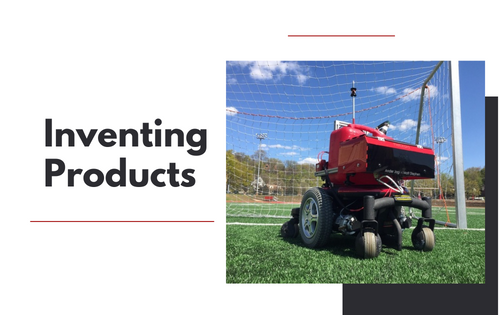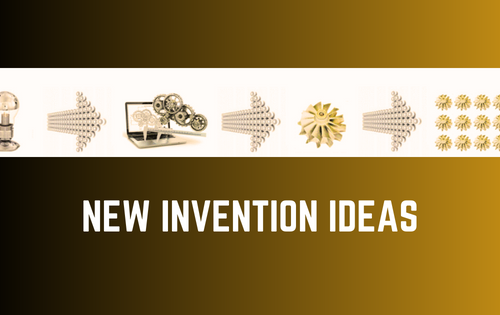Technology
Bringing Your Invention Idea to Life: Steps and Patent Services
The transformative moment from idea to invention can seem like a daunting task for any aspiring inventor. How do I start my invention idea? This question often lingers in the minds of many creative thinkers. Let’s see what are the basics of inventing, from patent searches to prototyping.
Refine Your Idea
The very first step for any invention is to have a well-defined and refined idea. To start with, clearly identify the problem your invention is trying to solve or the gap it aims to fill in the market. Developing a detailed description of your invention, including all its features and way it works, is paramount. This can include sketches, diagrams, and comprehensive notes that support the idea.
Conduct Market Research
Before diving into the patenting process, it is crucial to assess the commercial potential of your invention. Begin by identifying your target market—understand the demographics, preferences, and habits of potential consumers. Investigate the market to find similar products and assess how your invention differentiates itself from existing solutions.
Create a Prototype
A prototype serves as a three-dimensional proof-of-concept, whether functional or not, that demonstrates the design and functionality of your invention. Creating a prototype involves using digital tools to build a virtual model or actually making a physical model.

Protect Your Invention with a Patent
To secure exclusive rights to your invention and prevent others from profiting off your idea, obtaining a patent is critical. Start by conducting a thorough patent search to ensure your invention is unique and not yet patented. Next, submit a detailed patent application to the patent office that includes all necessary specifications, claims, and an abstract.
Getting Professional Help
Navigating the world of patents can be challenging and intricate. This is when patent agencies, such as InventHelp, come to the rescue with their expertise in patent services such as patent searches, application assistance, and legal advice. They can help conduct exhaustive patent searches to verify the uniqueness of your invention. They also provide support in drafting and filing patent applications accurately and efficiently. Furthermore, patent agencies usually collaborate with patent attorneys to offer essential legal advice and representation when needed.
In Conclusion
Inventors should remember that invention is an iterative process, requiring patience, resourcefulness, and creativity. Following a clear plan and seeking reliable support from patent services will go a long way in successfully bringing your invention idea to life.
What is a Patent and Do I Need to Patent My Invention Idea?
A patent is a type of intellectual property that gives an inventor the exclusive right to make, use, sell, or import an invention for a set period. In other words, it is a legal document that prevents others from capitalizing on your unique idea. The million-dollar question for many inventors and innovators is, “Do I need to patent my invention idea?”.
Understanding Patents
A patent is issued by the government, usually through the national patent office, to protect the inventor’s rights to their invention. This protection lasts for a specific duration, generally 20 years for utility and plant patents and 15 years for design patents, counting from the filing date. After the patent expires, the invention enters the public domain, and anyone can use the idea without seeking permission from the inventor.
Types of Patents
What are the different types of patents? There are three main types of patents:
Utility Patents – These patents are granted for inventions of new and useful processes, machines, articles of manufacture, or compositions of matter. A utility patent generally offers the strongest protection for an invention.
Design Patents – These patents protect the unique appearance or design of a manufactured product. It does not cover the functionality or underlying technical aspects of the product, only the ornamental appearance.
Plant Patents – These patents are granted for the discovery and invention of distinct and new plant varieties that are asexually reproduced, such as through grafting or budding.

Factors to Consider in Patenting Your Invention Idea
To determine if you need to patent your invention, consider the following factors:
1. Novelty and Non-obviousness
Your invention must be unique and not obvious for it to qualify for a patent. If it’s an improvement on an existing invention, the improvement must be significant and not apparent to someone skilled in the same field.
2. Commercial Viability
Consider if your invention has significant market potential. Obtaining a patent can be a time-consuming and costly process. Therefore, the commercial benefits of your invention should outweigh the expenses and effort involved in obtaining a patent.
3. Competitive Advantage
A patent ensures that your competitors cannot legally reproduce, sell, or use your invention. If you operate in a highly competitive industry, having a patent can provide you with a competitive edge and secure your market share.
4. Licensing and Investment Opportunities
A patent can be licensed to others, generating a passive income stream for the inventor. But, how do I license my invention idea? To license your patent, you will need to find a company that is interested in using it. You can start by performing a patent search and then contacting potential licensees directly or through an intermediary such as InventHelp invention assistance company.
Conclusion
The decision to patent your invention ultimately depends on various factors, including the uniqueness of your idea, its market potential, and the competitive landscape. If you decide to pursue a patent, it’s essential to consult with a patent attorney or an invention help company, like InventHelp, to guide you through the process and help protect your invention.
What to Do Once You Have an Invention Idea
Turning your idea into a reality may seem overwhelming, but with the right approach and guidance, you can successfully navigate the invention process. Many inventors are stuck with the question “What do I do once I have an invention idea?” There are many steps you can take to turn your idea into a reality, but the first is to determine if your idea is patentable.
What Is A Patent?
A patent is a government-issued license to commercially exploit your invention for a limited period of time. It is a form of intellectual property protection that prevents others from copying your invention without your permission. The first step in the process is to determine if you have an idea that qualifies for patent protection.
If your idea is not patentable, you can still turn it into a product or business. However, if your idea is patentable, the next step is to pursue a patent application.
How To Determine If Your Invention Is Patentable?
There are three basic requirements for patentability: novelty, usefulness and non-obviousness.
Novelty means that your invention is new, not previously published or patented. A patent will not be granted if it is an obvious variation on a previously existing idea.

Your invention must also be useful, meaning that it has a practical application. An idea for an unworkable device or process does not qualify as patentable.
The third requirement is non-obviousness. This means that your invention is not obvious to someone with ordinary skill in the field. This is a very difficult requirement to meet. It takes an expert to determine whether or not something is obvious. InventHelp invention company can help with the entire process of patenting your idea.
How To Bring Your Invention To Life?
Once you have a patent on your idea, you probably wander how to bring an invention to life. This is a process called product development. Product development involves creating a prototype of your invention and testing it for safety and effectiveness. InventHelp can help with this process as well.
InventHelp can help with the product development process. They have a network of experts in many fields who can help you create your prototype and get it ready for market.
Conclusion
InventHelp is a great resource for inventors. They can help you through every step of the invention process, from patenting your idea to bringing it to market. If you are an inventor looking for help with your next big idea, contact InventHelp today.
What Are My Options For Developing A Product?
If you have an idea for a new product, there are several options available to you. Invention ideas are a dime a dozen, but execution is the hardest part. There are many ways to bring your idea from concept to reality, and each has its own pros and cons.
What Are Your Options?
The first option is to develop your own product and market it yourself. This can be a long and difficult process, but it is possible if you have the time and resources.
Another option is to license your idea to a company that has the ability to manufacture and market your invention. This will usually require that you sign away some control over your creation in exchange for a percentage of sales or royalties.
The third option is to find an investor who will pay for all or part of the development costs in exchange for partial ownership of your invention, or even full ownership. This can be a good option if you have an invention that is particularly valuable and you don’t want to give up control. It’s also possible to pursue all three options at once.

A fourth option, which is often the most expensive, is to develop your invention yourself. This can be a daunting task, especially if you’re not an engineer.
If you decide to go this route, the most important thing is to keep the costs down. You’ll need an engineer or technical designer who can help you create a prototype and make sure it works as desired. You’ll also need patent attorneys or invention companies, such as InventHelp, who can file all of the necessary paperwork, which may cost several thousand dollars in fees and expenses.
What Is The Best Option?
If you’re trying to decide which option is best for you, consider your time, financial and technical resources. If you have the money, it may be worth hiring an invention firm or a patent attorney to file a provisional patent application on your behalf.
This will give you a year to further develop your invention idea and make sure it’s ready to go into production. If this sounds like too much work or expense for you right now, consider looking into other options that can help bring your product idea one step closer to reality.
Conclusion
If you’re still on the fence about whether or not to patent your idea, realize that it can be a powerful tool to protect your intellectual property and help push your product toward market. It’s important to weigh all of your options before making this decision so that you can make an informed choice.
The Process of Developing A New Product Idea
Developing a new product idea is an exciting journey – but it can also be complicated and overwhelming. Let’s break down the steps of bringing your idea to life, from conception to market-ready product.
Research
Before you can even begin to develop your new product idea, you need to do your research. This involves looking into the current market and seeing what gaps you can fill with your product. You should also determine who your target audience is and what your product’s unique selling points are.
Refine
Once you’ve done your research, it’s time to refine your new product idea. This means taking the time to think through all the details and develop a clear plan for how you want your product to look, function, and be sold. You should also consider the resources you need to bring your idea to life.
Prototype
The next step is to create a prototype of your product. This is where you can really start to bring your idea to life and test it out. Prototyping can be done through various methods, depending on the type of product you’re creating. For example, you may need to 3D print a model or use virtual reality to create a virtual prototype.

Test
Once you’ve created a prototype, it’s time to test it out. This means gathering feedback from potential customers to see how they react to your product. This will help you refine your idea and make any changes that need to be made before it’s ready to go to market.
Launch
Finally, it’s time to launch your new product! This will involve putting together a marketing campaign, developing a sales strategy, and getting your product out into the world. With hard work and dedication, you can bring your new product idea to life.
Get Help From Professionals
If you need help with any part of the process, it’s a good idea to reach out to professionals. InventHelp invention company is a great place to start. They can give you advice on what types of products are likely to be successful, as well as provide support throughout the process. Additionally, they will connect you with companies that accept invention ideas and help you get your product patented. If you want to bring your idea to life, it’s worth speaking with a company like InventHelp.
Conclusion
Bringing your new product idea to life is not an easy task. You’ll need to spend a lot of time and effort on it, but the rewards can be worth it. If you want to make money from your invention, it’s important that you have the right support in place.
How Inventions Have Changed Our World
Inventions have revolutionized the world, from the wheel to electric cars, humans have always been pushing the boundaries of innovation.
How Inventions Influence Our World
Inventions have allowed us to explore the world and beyond, to discover new ways of doing things and to live our lives more efficiently. From the invention of the wheel to the creation of the internet, humanity has seen drastic changes in the way that we live our lives.
Some of the most important inventor ideas have changed the world in a very short amount of time, while other inventions have taken centuries to become widely used. The invention of the steam engine, for example, revolutionized travel and led to industrialization. Inventions have drastically improved our way of life and opened up new opportunities for us to explore.
Impact of Inventions
Inventions have changed the way we interact with each other, the way we do business, and the way we travel. The invention of the telephone allowed us to communicate with each other from across the country, while the invention of the internet opened up a world of information and knowledge. Inventions have also allowed us to explore space, which has led to the creation of new technologies and possibilities. Inventions have even made our lives more comfortable through the invention of air conditioning, which has made living in hot climates more bearable.

The Future of Inventions
Inventions are always changing the way we do things and the future of inventions looks even brighter. Innovations in artificial intelligence and robotics are paving the way for a new era of automation and efficiency. New materials and technologies are being developed to make our lives easier and more comfortable. Inventions will continue to shape our world and make it a better place to live.
Inventions have changed our world for the better and will continue to do so for many years to come. And inventors are the people who make it happen. As long as there are new ideas and brilliant minds, and companies that help inventors, we will continue to see new inventions that make our lives easier, safer and more enjoyable.
Conclusion
Inventions have revolutionized the world and changed our lives in countless ways. From the invention of the wheel to the creation of the internet, inventions have allowed us to explore and discover new opportunities. Inventions have made our lives easier and more comfortable and will continue to do so in the future. By understanding how inventions have changed our world, we can make the most of the opportunities that they bring.
What Are Backlinks in SEO
Backlinks are one of the most important factors in search engine optimization (SEO). A backlink is simply a link from one website to another. When a website links to your site, it signals to search engines that your content is valuable and relevant.
How Can Backlinks Improve Your Rankings on SERPs?
Backlinks can improve your website’s search engine rankings in several ways. First, search engines consider the number and quality of backlinks when determining the authority of a website. The more high-quality backlinks you have, the more authoritative your website appears to search engines.
Second, backlinks can help search engines discover new pages on your site. When a search engine crawls a website, it follows the links on that site to discover new pages. If your site has quality backlinks from other authoritative sites, search engines are more likely to crawl and index your pages.
Finally, backlinks can drive traffic to your website. If someone clicks on a link to your site from another website, they are directed to your site and have the potential to become a customer or client.
However, it’s important to note that not all backlinks are created equal. Quality backlinks come from authoritative websites in your industry or niche. Low-quality backlinks from unrelated or spammy websites can actually harm your SEO and lower your search engine rankings.
How To Get Backlinks?
There are many ways to get backlinks, but here are a few of the most effective methods:
Write guest posts – Write a blog post on another website in your industry and submit it as a guest post. Include a link to your website at the bottom of your post. Guest blogging has been shown to be one of the most effective ways to get backlinks, but you should only do it with websites that are relevant to your industry and have a large following.
Write press releases – Write a press release that announces an event, product launch or other newsworthy item related to your business and submit it to several websites. Include links in the body of your release for more exposure.

Create infographics – Infographics are an easy way to get backlinks, as many websites will include them in their posts. Create an infographic based on an interesting statistic or trend related to your industry and submit it as a guest post on another website.
These are just couple of ways to get high quality backlinks. Don’t be afraid to experiment with different tactics and see what works best for your business, as each industry will have its own set of challenges.
Hire An SEO Agency For Backlinks
If you don’t want to go through the process of creating backlinks on your own, consider hiring an SEO agency. These companies will create high quality backlinks for your website, which can help improve its rankings in search engines. They will also monitor how effective their strategy is over time, so they can make adjustments when necessary.
Boomcycle Digital Marketing Agency can help you get backlinks from high quality websites. They can also create content for your business that will attract links, which can help improve your rankings and increase traffic to your site. Boomcycle agency offers a variety of services, including SEO, content marketing, webdesign and social media management. They also offer a comprehensive digital marketing audit, which can help you determine what strategies will be most effective for your business.
Conclusion
If you’re looking for a digital marketing agency that can help you get the most from your online presence, then Boomcycle is a great choice. They have years of experience helping clients grow their businesses, and they will work with you to develop a strategy that will boost your rankings and increase traffic to your site.






